Resovia Rzeszów sit in the relegation spots of Poland’s second tier, 1 Liga. In early December, they appointed a new head coach, Rafał Ulatowski, who has spent time in the Polish national team’s coaching setup and has experience across a host of Ekstraklasa clubs throughout his nearly 30-year-long career in coaching.
Resovia Rzeszów’s set-pieces have been eye-catching both before and after the managerial change, with them accounting for 24% of their goal total in the league this season. These set plays have given the club a fighting chance of staying up in the division, and with an upturn in form since the arrival of Ulatowski, survival is a real possibility.
In this tactical analysis, we will look into the tactics behind Resovia Rzeszów’s attacking corner kicks, with an in-depth analysis of their use of backward separation to create high-quality chances. This set-piece analysis will also look into the reasons why they insist on delivering the ball into the six-yard box, the different creative routines they’ve used, and how they could improve in the future.
Attacking the Six-Yard Line
Resovia Rzeszów’s aim is to gain access to the six-yard line, from where any header towards the goal is almost certain to result in a goal, giving that area the tag of ‘high-value’. They use four deeper attackers around the penalty spot, as well as one attacker inside the six-yard box, with all five players attempting to attack different points of the six-yard line to give the corner taker the safety in overhitting or underhitting a cross and Rzeszów still having the opportunity to make the first contact. They also use one attacker to pin the goalkeeper to his line, giving the corner taker more leeway to make sure the cross does not get intercepted.
The success rate of this method varies from game to game, depending on the positioning of zonal defenders and their quantity, which determines how much space is protected. As we can see in the image below, with only two zonal defenders located near the six-yard line, there is plenty of space on both the near and far edge of the six-yard box for an attacker to arrive in and make the headed effort on goal.
The four attackers who start deeper do not use any extra aids to help them gain separation and enter the six-yard box unopposed. Instead, they fend for themselves, relying on sharp movements to lose their markers and get goalside. It could be possible to increase their chances of creating separation through teammates setting screens for each other or by altering either the angle or distance of the run into the six-yard box. However, with Rzeszów failing to do so, we often find these attackers from deeper being quite ineffective.
As a result, the player who usually finds space along the six-yard line is the one attacker whose starting position is inside the six-yard box, and he moves away from the goal as the kick is taken, creating backward separation. With so few zonal defenders, it is possible for the attacker moving away from the goal to find space in the high-value areas. In contrast, the only zonal defender is focused on the typical run made from the penalty spot, forgetting about the movement from over his other shoulder.
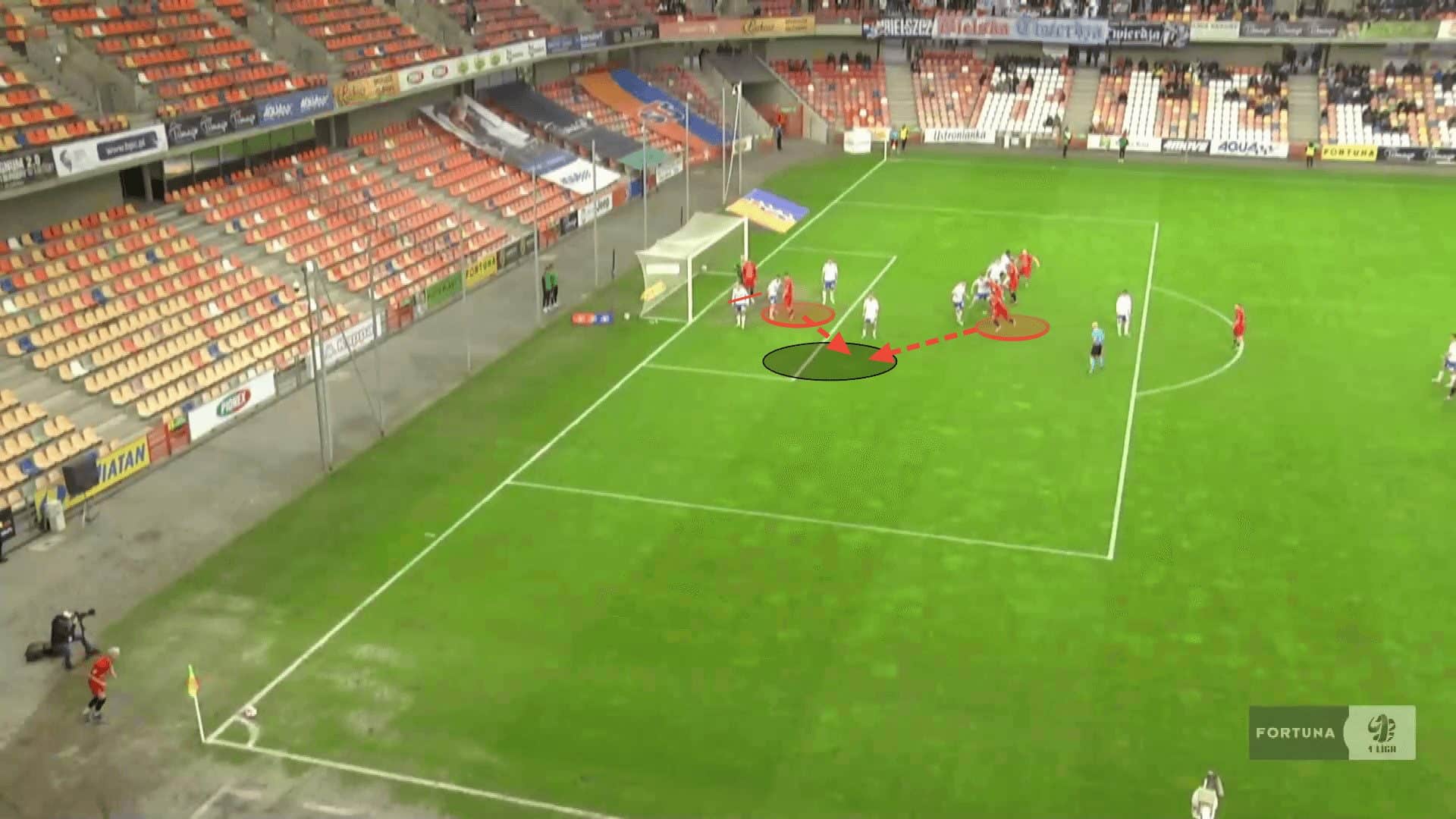
Separation refers to an attacker moving away from his marker, dismarking himself, and having the time and space required to redirect a header/shot toward goal. Backward separation is when the attacker moves into space, which is further away from the goal than his original starting position. It is naturally easier to gain in comparison to the usual separation we see during set plays, since when a defender is goalside, an attacker has no one blocking his path to move away from the goal, as that is what is commonly thought of as a less threatening action.
If you ever see anyone move away from the goal, it is thought of as a positive, that the goal is in less danger. It can also be harder for an attacker to get as much power on a shot or header when their momentum is taking them away from the goal.
However, as we referred to earlier, when that movement away from goal still leaves the attacker in a high-value area, it doesn’t matter that the attacker can’t generate much power on the effort on goal, as any touch is likely to beat the goalkeeper who has so little time to react.
The marker of the attacker highlighted below must remain goalside to avoid giving him the easy chance should a cross fall perfectly on his head. As the kick is about to be taken, the attacker makes a move towards the ball, forcing his marker to start moving towards the ball. With good timing, the attacker then makes his move away from the goal, as his marker is watching the trajectory of the ball, giving the attacker the yard of space he needs to redirect the header towards the goal.
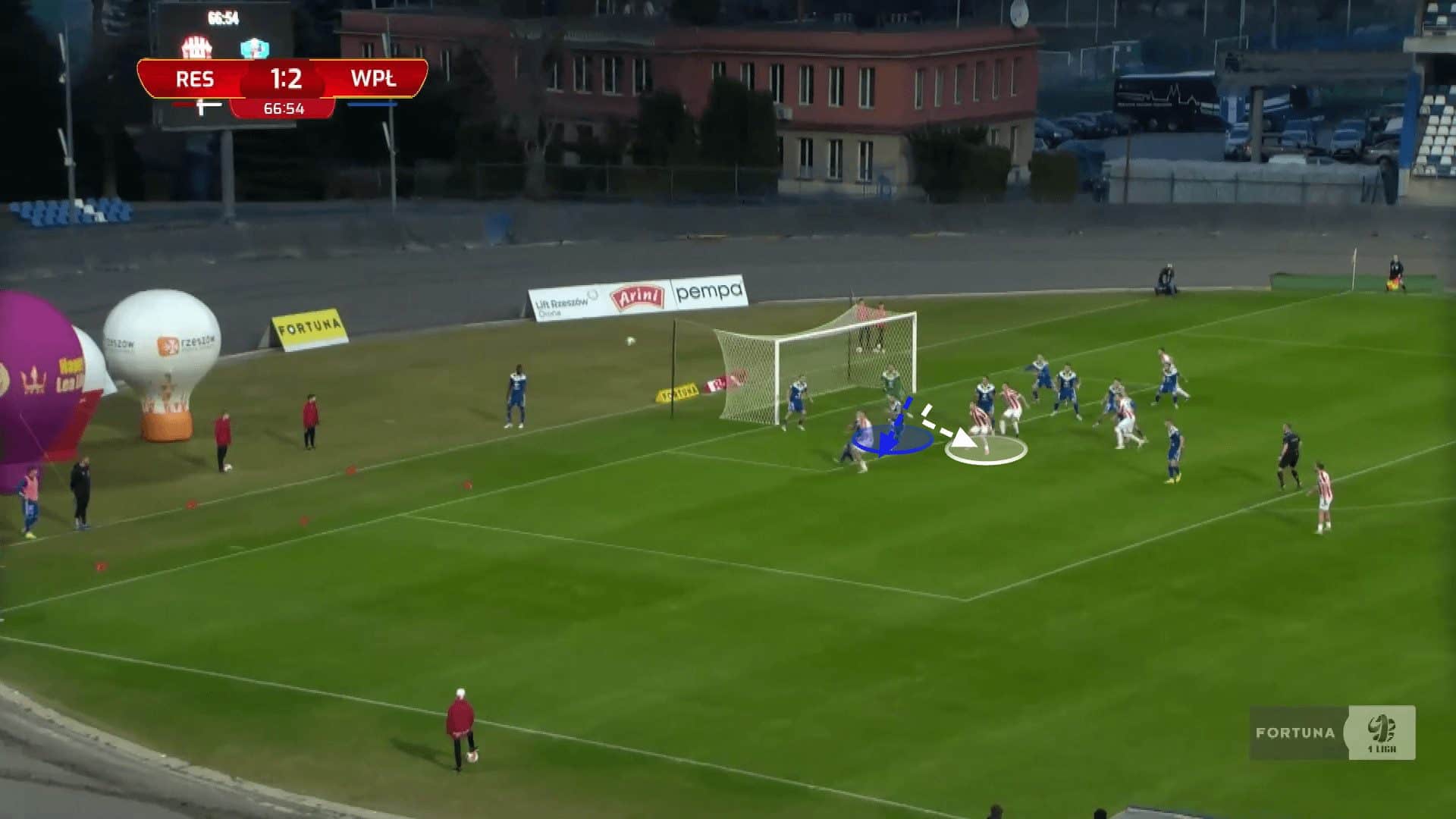
Crowding the Six-Yard Box
As mentioned earlier, Resovia Rzeszów have mostly been effective through the attackers who start inside the six-yard box, before attempting to create backward separation. Recently, they have adapted their routine to move the attacking unit into the six-yard box, where more players have the opportunity to gain backward separation.
The image below highlights this, with six attackers inside the six-yard box. One player’s job remains to block the goalkeeper, whilst one player attempts to arrive at the near side of the six-yard box, recovering any under-hit crosses by flicking them into the six-yard box. The remaining four attackers all attempt to force their markers as deep into their goal as possible, which then gives them space around the six-yard line to meet the ball and head it goalwards.
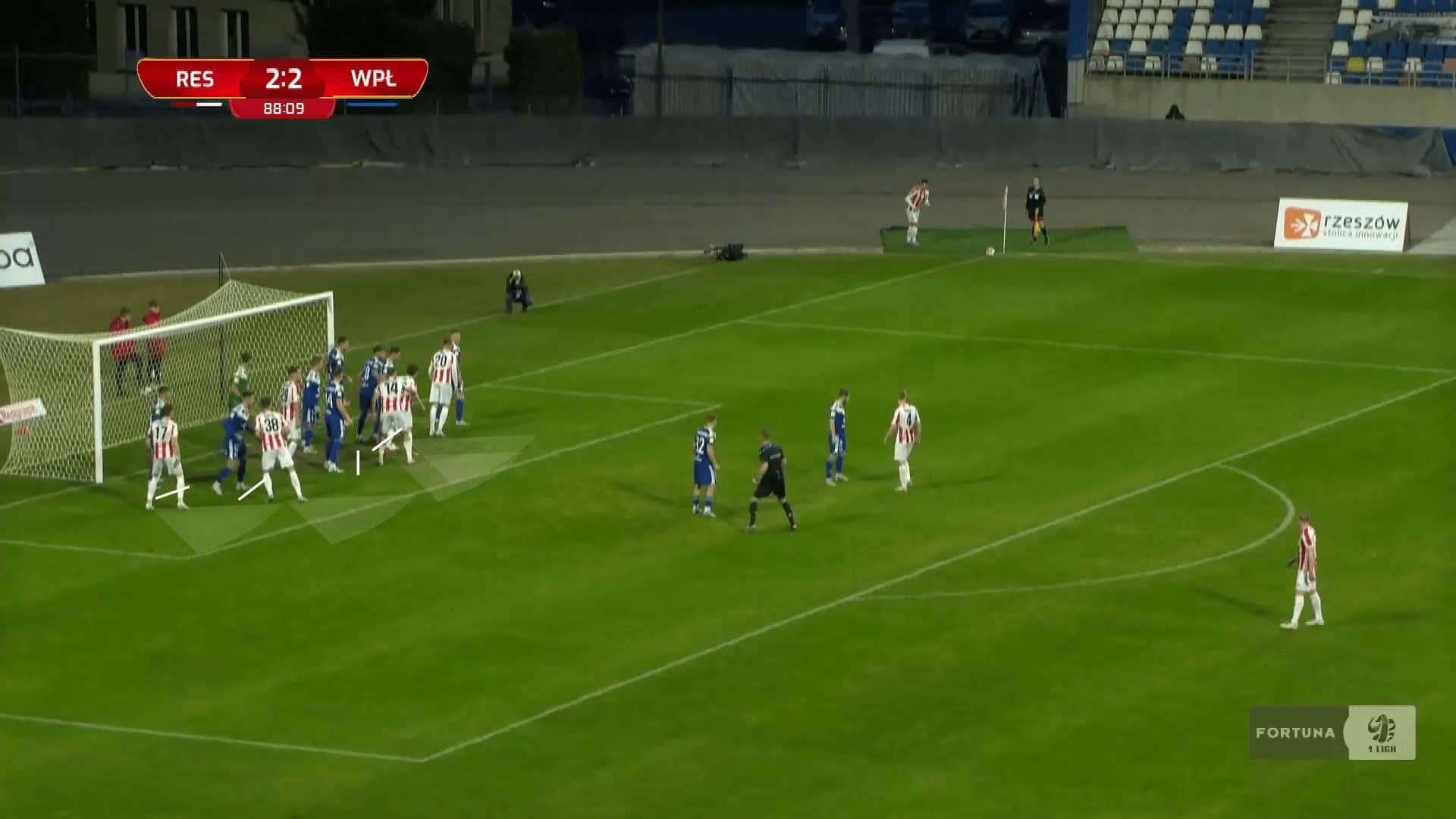
When an attacker has his back to their marker, like in the example below, they are essentially setting a screen for themselves, blocking the defenders from being able to move into the area highlighted below. The attackers are able to block the path of their marker to the target area and time the movement to arrive in the area as the ball does, giving the defender no chance of stopping the cross.
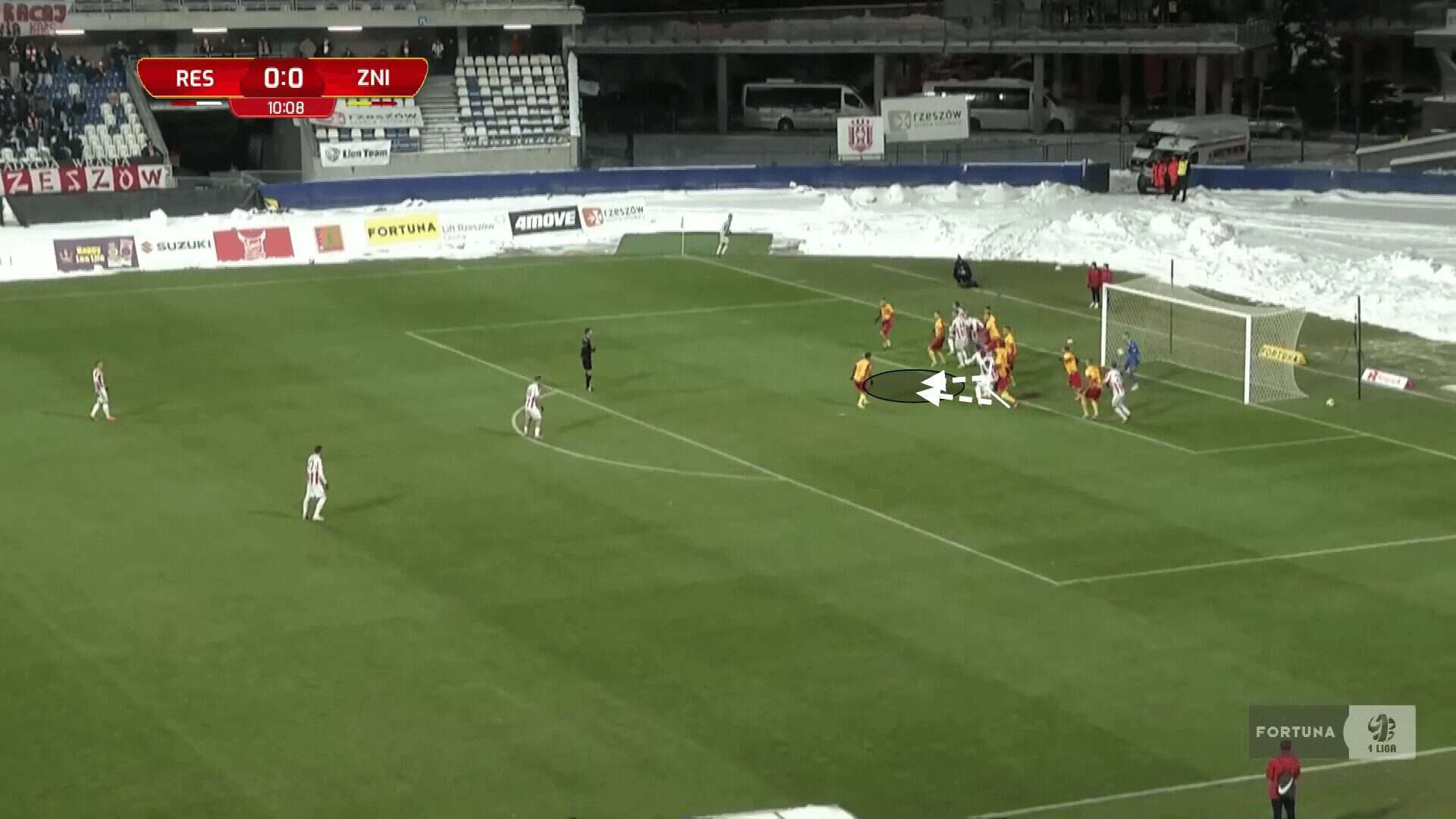
A natural additional benefit to crowding the six-yard box is the increased potential to prevent the goalkeeper from claiming a cross. It depends on the delivery, but many balls delivered into the six-yard box can often be claimed by the goalkeeper. However, with the increased traffic inside the six-yard box, goalkeepers must first attempt to navigate their way past the opponents before attempting to claim the cross. As a result, goalkeepers often are rooted to their line, giving the attackers the chance to compete for aerial duels inside the six-yard box, where a goalkeeper would usually claim it.
In other instances, like in the example below, goalkeepers attempt to claim the cross but end up putting it back into play, due to the difficulty of catching the ball with multiple attackers competing for the ball. This creates opportunities in the second phase for Resovia Rzeszów. However, they have a limited number of players, usually one, waiting outside the six-yard box to collect the loose balls.
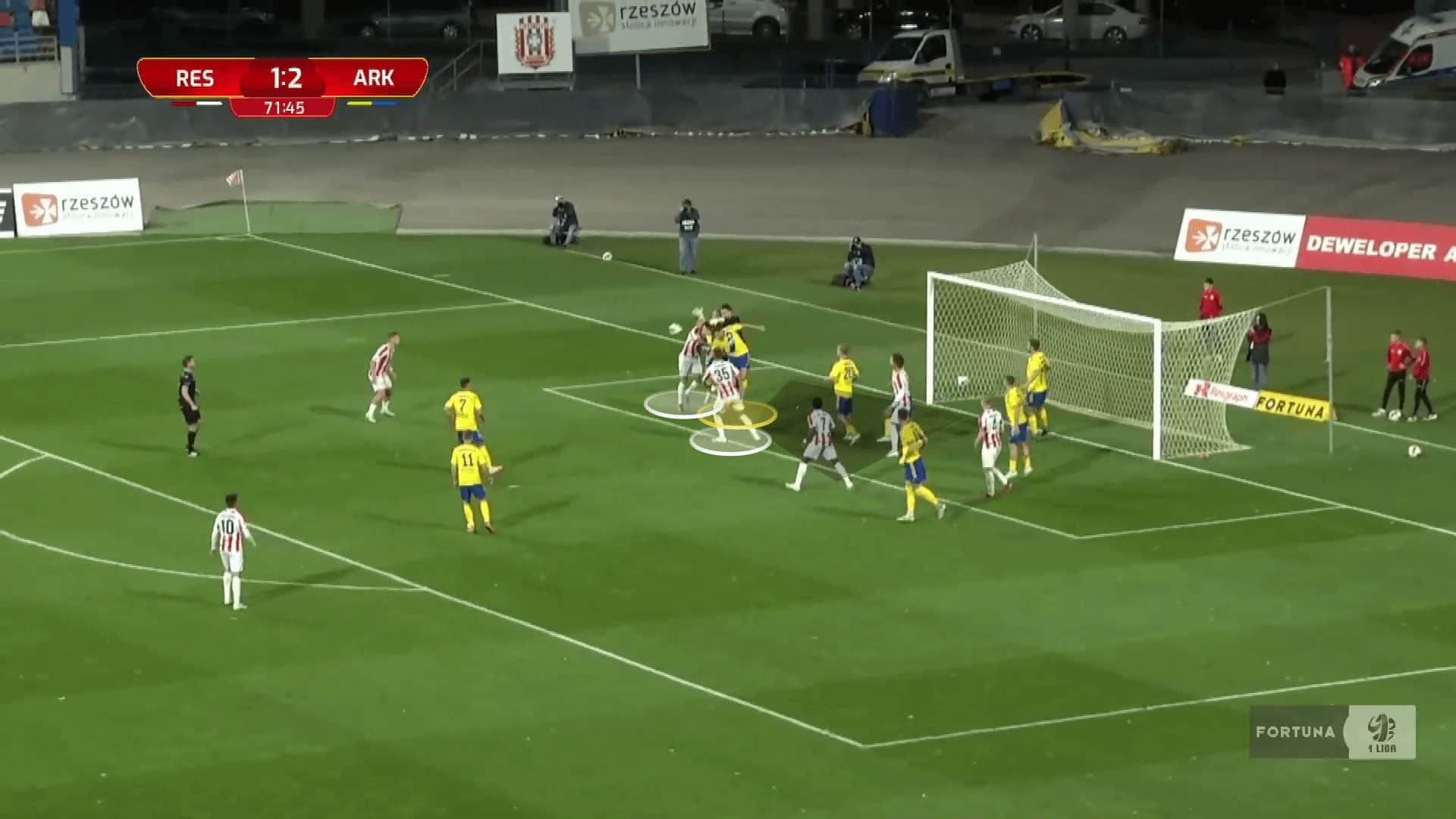
Original Routines
As mentioned near the start, Resovia Rzeszów attempt to attack the area around the six-yard line. When each attacker starts around the penalty spot, they have often struggled to have even one attacker create separation for themselves at the six-yard line. This has caused them to devise more adventurous ways of setting up to give each attacker the easiest possible way of arriving at the unmarked six-yard box.
One way in which that has been made possible has been through the choice to scatter the starting positions of each player. Each attacker is spread out in the image below, giving each player as much space as possible to make losing their marker a more likely occurrence. With extra space, attackers have the option to go as wide as possible when arcing their run, to miss their marker.
Usually, when a group of attackers start side by side, the central attacker has no space on his left or right to attack the six-yard box, as his teammates and their markers block off his potential paths. With the scattered setup, each attacker has the option to evade their marker on the left or the right.
Each attacker then attempts to attack all the different gaps between the zonal defenders to ensure a Resovia Rzeszów player makes the first contact, no matter where the ball goes. Although this approach does increase the rate at which attackers from deep can lose their markers, it still relies on each attacker having good enough movement and timing skills to lose their marker and arrive at the six-yard line at the right time.
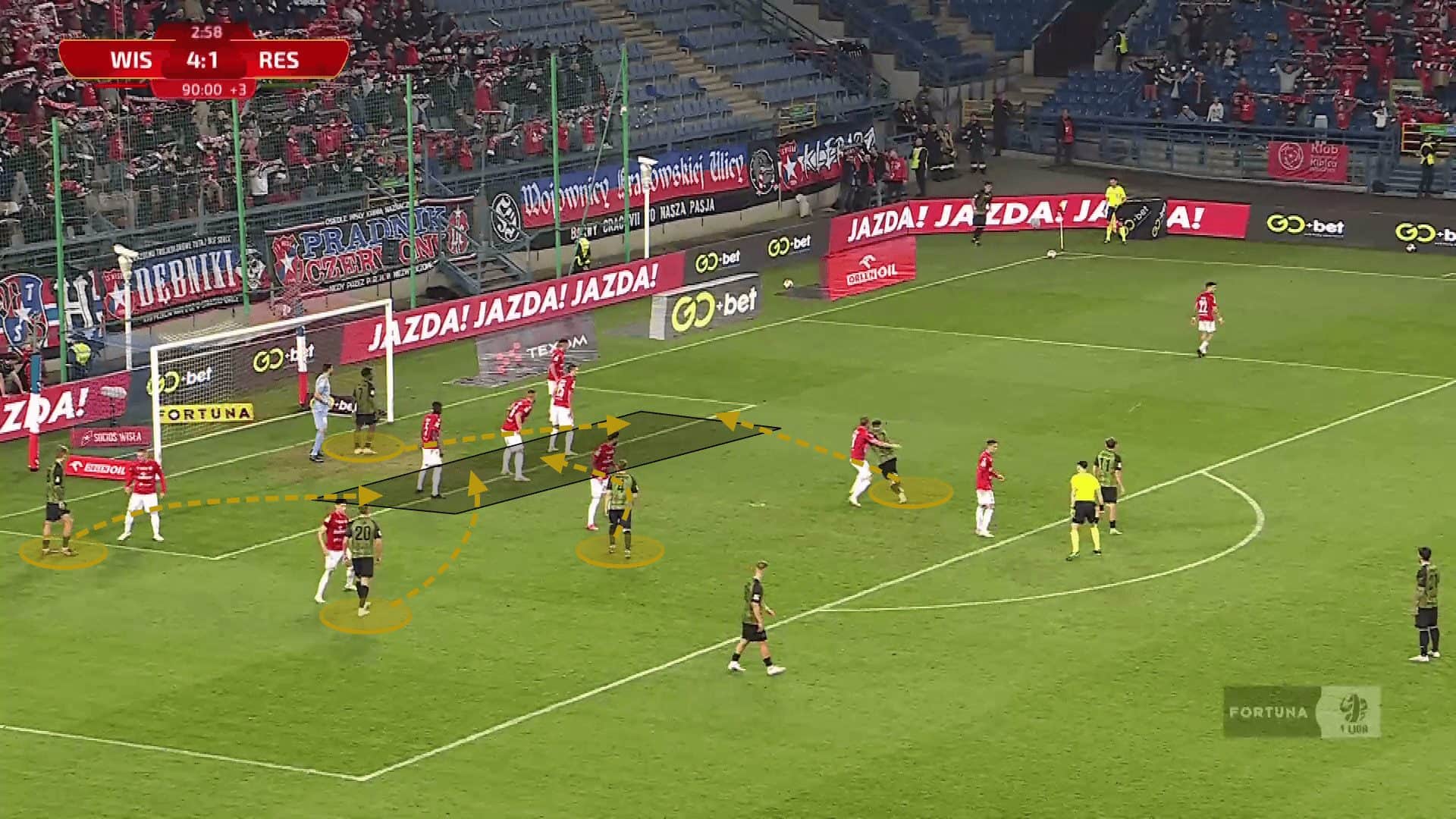
One slight alternative method has been to use a train of players at the back post, similar to what Arsenal have been doing in the Premier League this season. Each attacker is positioned in the defender’s blind side, giving them the instant separation they are looking for. However, due to the limited number of attempts they have had with this routine, there have been issues with timing. Still, it is a little puzzling that, as with every routine attempted in this current section, why it has been attempted in one game and almost instantly ditched.
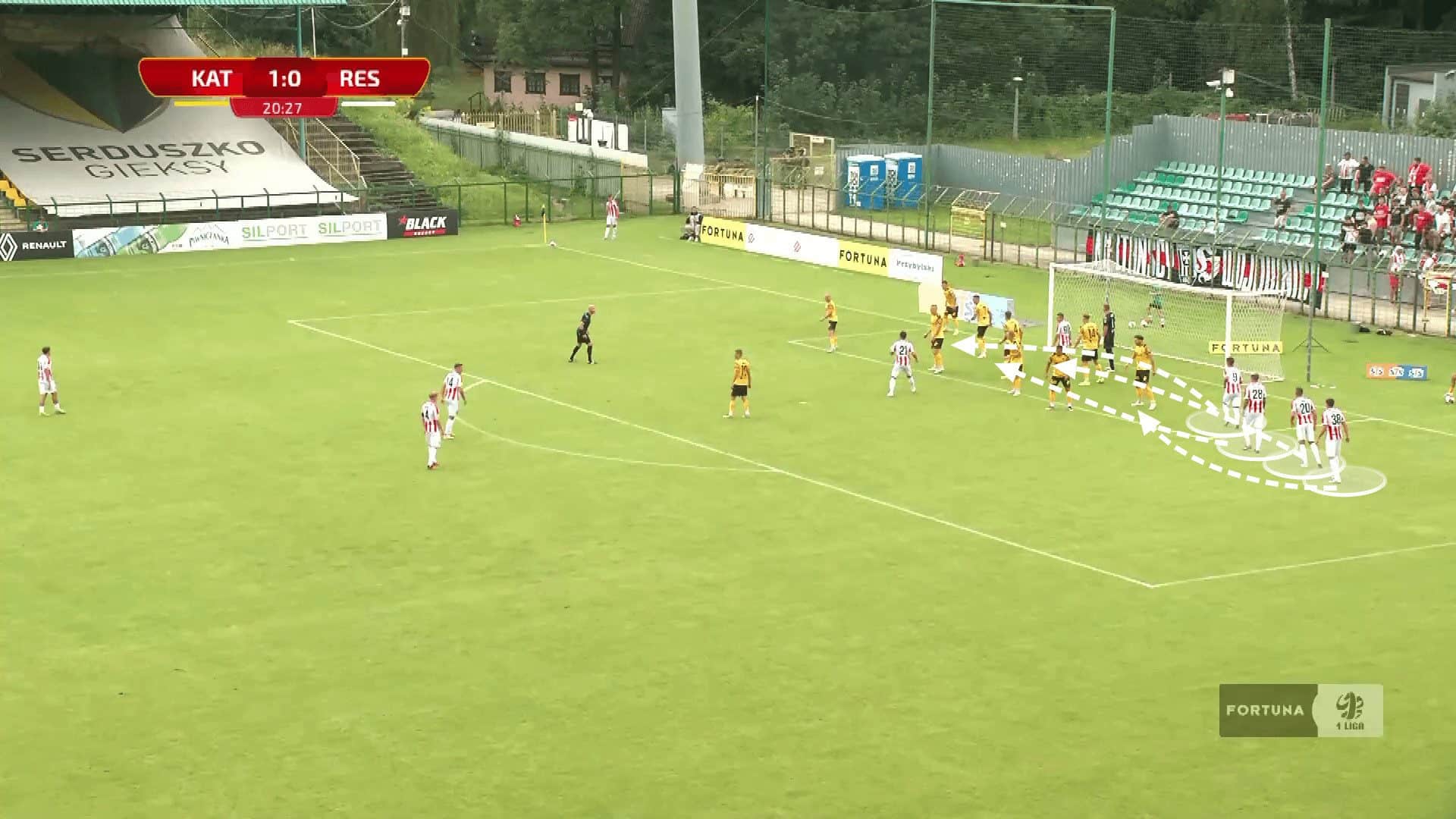
This particular routine was attempted at the start of the season, leading to a goal, but has not been attempted since. We can see in the image below, that the attacking unit all making moves toward the six-yard box, as they usually do. However, instead of the ball being played to the six-yard line, it is hooked back to the edge of the penalty area, where the player from the far side of the box is arriving to meet it. To ensure he can get his shot off, the player’s marker is prevented from reaching the target area through a screen from a teammate. Rather than looking for a flick in the high-value areas, the ball is played to an area that is slightly less valuable but is still close enough to cause the goalkeeper massive problems.
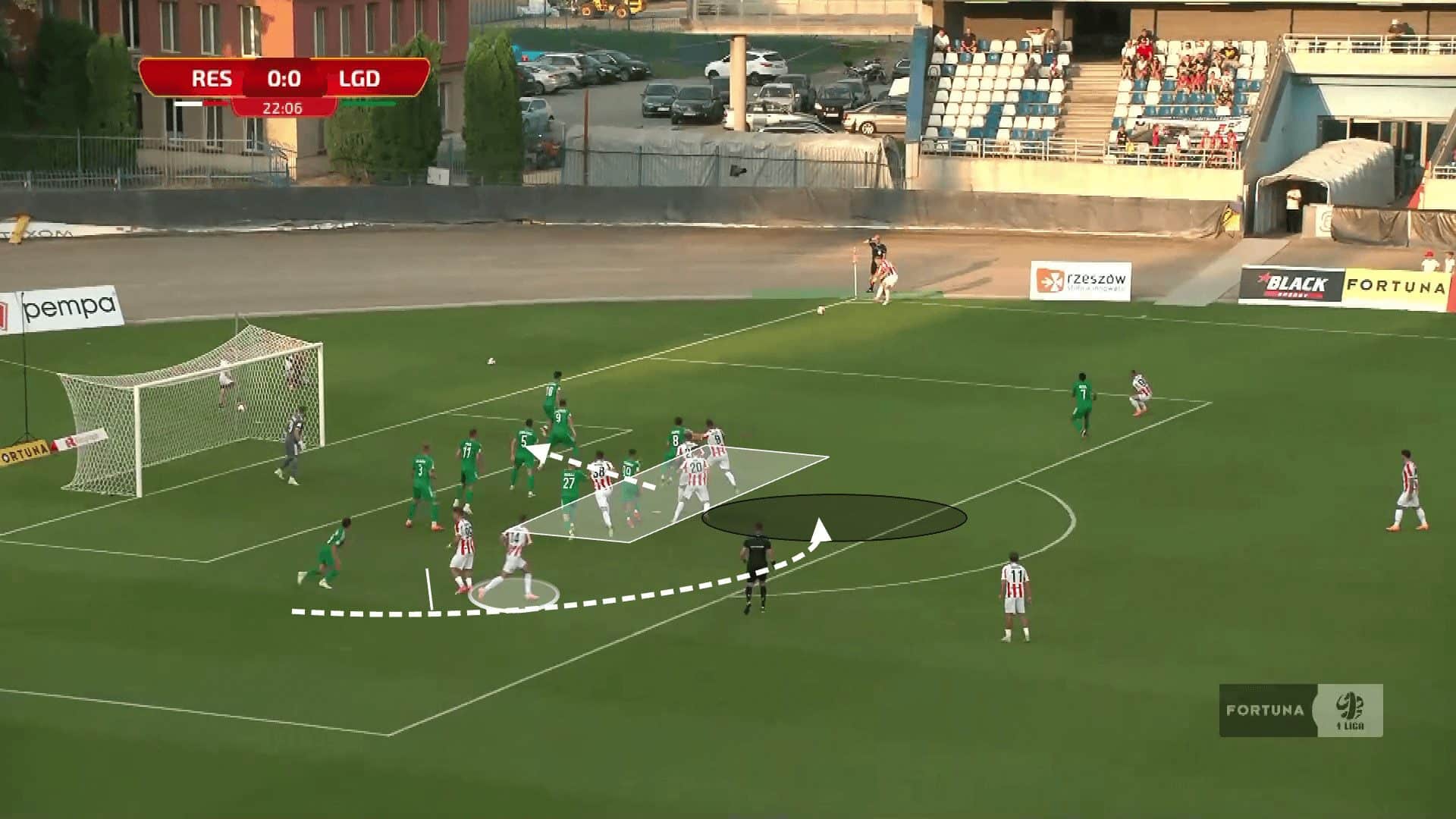
The final variation that Resovia Rzeszów have used this season is one inspired by Eddie Howe’s Newcastle and Bournemouth sides. Two runs are made away from the penalty area, dragging defenders away from the box. The short corner is played to the furthest player on the left, which is highlighted in the image below. With his body facing away from the goal, defenders are lured in to press the ball, thinking they can get a tackle while the attacker has limited vision. Once the defenders have left the black area in the image, the player on the ball rolls it behind him into that space, whilst the corner taker has made sure to come back onside and can arrive in the black area unmarked, with no one taking the responsibility to mark the corner taker.
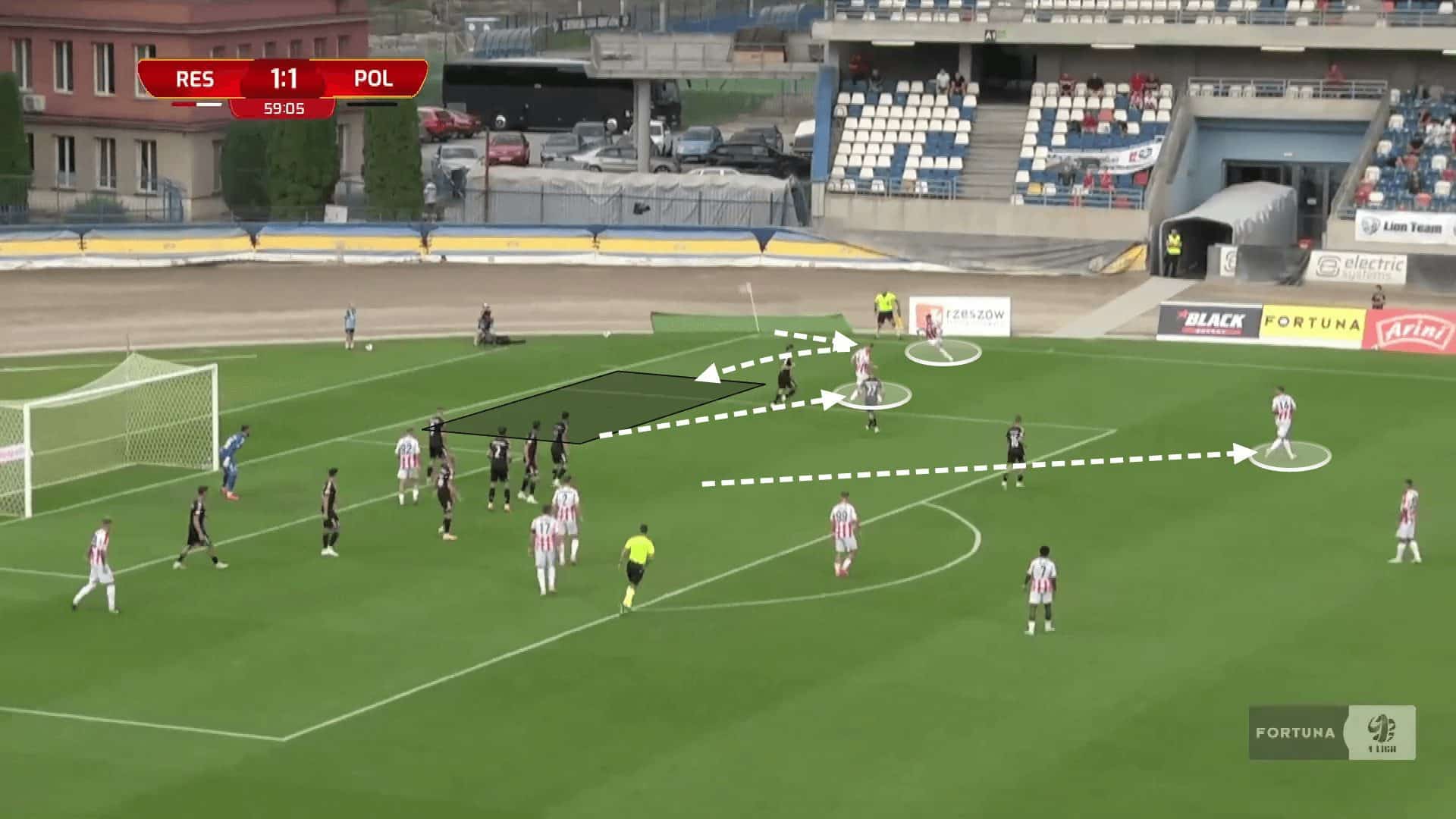
Summary
This set-piece analysis has shown the numerous different ways that Resovia Rzeszów have been able to create clear-cut goalscoring opportunities from corner kicks this season. They have stuck to a theme of creating backward separation for their attackers in order to have an easier way of accessing high-value areas from where the contact on the ball doesn’t have to be strong. Their ability to manufacture new ways of creating space for attackers has been informative and entertaining. However, it also leaves you questioning why some of these ingenious methods aren’t repeated from time to time, as their primary method of creating chances is less effective than the spin-offs used from game to game.






Comments